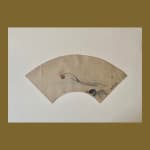



Seisenin Kano
Kagaribune, circa 1830
sumi and color on paper
10 1/4" X 3/4" work,
11 1/2" X 14 1/2" framed
11 1/2" X 14 1/2" framed
Further images
I found this little gem, painted on fan-shaped paper, in a private collection in Kyoto. It shows a fishing method using fire to attract fish at night—a tradition started about...
I found this little gem, painted on fan-shaped paper, in a private collection in Kyoto. It shows a fishing method using fire to attract fish at night—a tradition started about 370 years ago and is still used today. The boat is equipped with fire at the bow of a small flat-bottomed Kagari-Bune boat—the title of this work.
The fire-and-bow fishing method catches Ayu fish, also known as sweet fish or palatoglossus altivelis. Ayu fish is super delicious and available only for a short season. It is best when they are barbecued with a little bit of salt on the open fire. Even the smoke is fragrant. At night, it is a beautiful sight to see the glow of the fire and the boats’ reflections as they welcome summer.
This work may have been a piece for a Harimaze-Byobu—a screen with several small, individual artworks attached. One artist often creates works on a Harimaze-Byobu, but sometimes, two or three artists contribute to the screen.
about the artist
Seisenin Osanobu (1796 - 1846) was a member of the Kano School—one of the most influential hereditary schools in Japanese art (over 300 years old). Osanobu created many masterpieces that are now in museum collections worldwide.
Osanobu entered the service of the Shogun at the Edo Castle when he was only 15 years old. He started a journal before entering the service and continued journal writing until the day before his death. The Journal is now in the Tokyo National Museum of Art collection.
The fire-and-bow fishing method catches Ayu fish, also known as sweet fish or palatoglossus altivelis. Ayu fish is super delicious and available only for a short season. It is best when they are barbecued with a little bit of salt on the open fire. Even the smoke is fragrant. At night, it is a beautiful sight to see the glow of the fire and the boats’ reflections as they welcome summer.
This work may have been a piece for a Harimaze-Byobu—a screen with several small, individual artworks attached. One artist often creates works on a Harimaze-Byobu, but sometimes, two or three artists contribute to the screen.
about the artist
Seisenin Osanobu (1796 - 1846) was a member of the Kano School—one of the most influential hereditary schools in Japanese art (over 300 years old). Osanobu created many masterpieces that are now in museum collections worldwide.
Osanobu entered the service of the Shogun at the Edo Castle when he was only 15 years old. He started a journal before entering the service and continued journal writing until the day before his death. The Journal is now in the Tokyo National Museum of Art collection.



